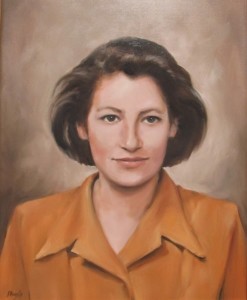Luck was liberated by Soviet troops in the beginning of February, 1944, and the Germans were expelled from their village. Although she was now free and the first days after the liberation looked like the end of a nightmare, she could not be happy, different from everybody else around. She wanted to visit her brother Moniek now that the Germans were no longer a danger, so she went to the house of the old German lady that had hidden him.
Before she reached the house, one of the neighbors came and told her that, as soon as the German lady learned that their family had been exterminated, she took Moniek and delivered him to the Nazis. Her world was again in ruins, but what could she do?

She decided to go to Luck, but did not find any of her relatives. Few Jews had survived in Luck and many of them were still afraid to leave their hiding places. The few Jews that she met told her what had happened to the group of Jewish men that had been summoned to forced labor when the Germans occupied Luck: they had all been executed, including her father and her uncle. The Jews that had remained in the ghetto had suffered miserably in the winter, dying of famine and sickness, until the day of the great slaughter. Those who had been sent to slave labor camps had rebelled when they realized that the Nazis were going to execute them; they had fought bravely and died as heroes.
Miriam went to see the daughter of the Protestant pastor, who recognized her and told her that her uncle’s sewing machine was there and she could take it back as soon as she wanted. She could not find Bolka, Aunt Anna’s former maid. She had gone somewhere else and her house was empty. She then decided to go to the office of the NKVD, the Soviet Police, and told them what the old German lady had done to her brother Moniek. They told her they would arrest the German lady, but how would she know this was true?
Miriam also requested from the Russian authorities the house of her uncle in Kopaczówka, but it had been occupied by other families. She and Stefcia, who desired to be independent from her in-laws, moved to her uncle and aunt’s former room – the only one available. A Jewish Russian soldier helped her to go to the houses of the villagers that had hidden her uncle’s valuable objects at the beginning of the war. Some of them did not want to return anything, but when the soldier threatened to come back with NKVD guards, they gave up the hidden goods, or at least part of them. All the while, she was aware that other surviving Jews who had attempted to recover their belongings or houses had been killed by the new occupants.
Meanwhile, she got back to school – the only Jewish child in the school.
Many solitarian Jews who had survived the Nazi occupation came to live in Kopaczówka; some of them lived together in the same house. One of them told her that some Jews had hidden themselves in the same forest of her family’s bunker; they had come and buried her family in the bunker at night.
One day, Stefcia’s husband returned from the Army. However, he did not stay for long, after having made his mind to return to Russia.
Continue reading: Return to Jewish Origins